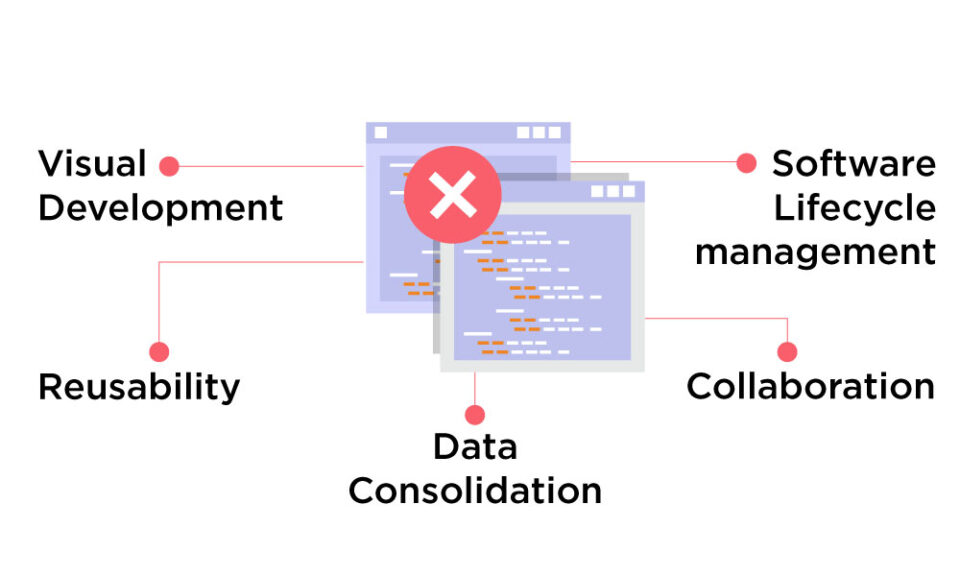Software development has reached a different dimension lately with new methods and approaches. Low code and no code are the prominent methods of software development contemporarily that highly depend on model-centric interfaces. Unlike traditional development styles that require high-code-based technical skills, low code development is compatible for experienced and trainee developers.
Experts assert that more than 27% of application developers spend five to nine years in coding, alongside 20% of developers spending 10 to 14 years for the same. Such numbers depict the significance of software development through coding, which consumes considerable time. Sources also highlight the evolving software development industry that has contributed to overall digital transformation across industries, with a valuation of $704 billion, which is about to surpass $898 billion by 2029.
The gradual evolution of software development and digital transformation has boosted the requirement for a more flexible development method, ultimately contributing to the emergence of low-code development. Data depicts that by 2025, 70% of software will be constructed using no-code or low-code development tactics.
This article will revolve around low code development, how it works, and its benefits. Let’s dive in...
What is Low Code Development?
Low code development refers to a software development method that asks for low or no hand coding while building an application. It is a model driven process that has drag-and-drop features making development easier and convenient. Additionally, it transcends coding tactics from texts to visuals using relevant tools. Since the method depends remarkably on models, it automates many tasks and reduces the requirement of orthodox programming techniques.
Low-code development platforms enable businesses to formulate software as per their unique requirements, integrating distinctive features and attributes to fulfil organizational goals. Alongside limiting traditional coding process, the method also reduces the requirement of constructing frameworks, user interface creation, data modeling, and others.
The software development technique can be significant in building applications for data analysis, customer engagement, ERP, and remote work management, and others. Low code development is progressing immensely in the commercial sector following a high implementation rate across industries. It is set to restrict development duration by 50% to 90%. Considering such an acceleration, more than 33% of companies are strategizing to integrate this development process.
How Does Low Code Software Development Work?
Model Construction:
Since the low code development method relies on models, developers primarily need to process relevant data for model construction. Such an approach helps streamline the flow of development, offering a structure to the entire process. Determining the entire process further support in building customized application for specific needs.
Information Gathering:
The following stage includes form creation to gather relevant information for software building. Low-code application development allows ready-to-use widgets that are user friendly as well. This phase also includes business rules according to which developers build software. Furthermore, a low-code environment assists in automating repetitive tasks in software establishment which require continuous human intervention.
Development:
In the third phase, developers build applications based on the gathered information. The low code approach requires minimal coding enabling users to modify and change default code to add unique features to the software. This method enables visual development and pre-built templates which contributes to developers’ time and resource saving endeavors.
Testing and Execution:
After building software, developers need to test the same and execute quality enhancement plans. Continuous testing helps identify the weaknesses and issues in the software. To fix such issues and boost the efficiency of the application, developers adopt certain procedures. Low code development enables multiple testing opportunities to elevate software performance and detect technical issues. Moreover, the method also initiates feedback to suggest what changes can be made to bring efficiency to the application.
Deployment:
The last stage of application development includes the deployment of the software, including its installment, configuration, and set up process. A low code environment offers real-time update of the functionality, features, and other elements to evaluate the performance of the developed software.
Benefits of Low Code Development

Visual Development:
Low-code system enables visual modeling of software that makes the development process more convenient and user-friendly. With drag-and-drop feature, the method allows utilizing a compelling user interface which makes the entire process easier. A model-driven approach lets developers foresee or pre-determine how their software will work and perform. The visual ability helps in boosting efficiency in the development process.
Reusability:
Low code systems unlock several reusable tools such as pre-built and pre-tested templates and modules, integrating seamless activities. Such capabilities help developers to enable scalability in their process, additionally bringing efficiency.
Data Consolidation:
Data consolidation and integration is not difficult in low code development. It allows data integration from diverse sources and systems. Alongside seamless integration, a low code method ensures security of used data, keeping suspicious elements away from the development process.
Collaboration:
The low-code method enhances collaboration among functional teams while developing software. It also offers several tools that assist teams across domains in an organization in collaborating and productively contributing to the development process. Messaging, project tracking, feedback, etc., are among the attributes of these tools. Effective collaboration and partnership within the organization limit the requirement of rework.
Software Lifecycle management:
Software development includes several stages, such as planning, executing, development, testing, and deployment. It is necessary for developers to monitor and manage each stage while establishing a flawless application. Low code development offers tools and features to streamline the entire process by monitoring each phase, allowing the management of the software lifecycle. The approach of low-code lifecycle management is quite flexible and holistic as it integrates automation.
Limitations of Low-code Software Development
Integration:
Integrating existing datasets and resources with the low code system can be challenging. Generally, low code facilities are offered by third parties and consolidating their services with legacy systems of an organization can be complicated due to compatibility issues. Moreover, connectivity can also be a challenge while initiating the integration process.
Security:
Security is one of the key concerns of software development, and it can devastatingly impact the entire procedure. Low-code systems are owned and managed by third parties; hence, in case of any vulnerabilities in their system or network, application development activities can encounter significant setbacks. Therefore, it is important for developers to consider security factors when choosing an appropriate service provider.
Required Skillset:
Though low code development is convenient for both experienced and novice developers, it requires a specific skill set that can contribute to the execution of all operations. The entire process includes many complex stages, where making mistakes can be highly costly. Furthermore, a lack of skills can also impact the features and performance of the application. An appropriate skill set can help unlock all the competencies of a low-code environment.
Concluding Remarks!
Low code development can doubtlessly transform the tech sector and offer several opportunities for effective software development. Flexibility, automation, collaboration, weakness detection, software lifecycle management etc. are common advantages of low code environment which empower developers to become highly productive.
The method has truly revolutionized the orthodox code-based development tactics and contributed to the progression of the global software market. Nevertheless, such processes also have certain limitations, such as security and integration complexities. Hence, organizations need to assess service providers and their offerings before integrating low-code software development.
Was the article insightful? If so, then read our other valuable content!
Recommended For You:
Everything You Need to Know About Ad Impressions




